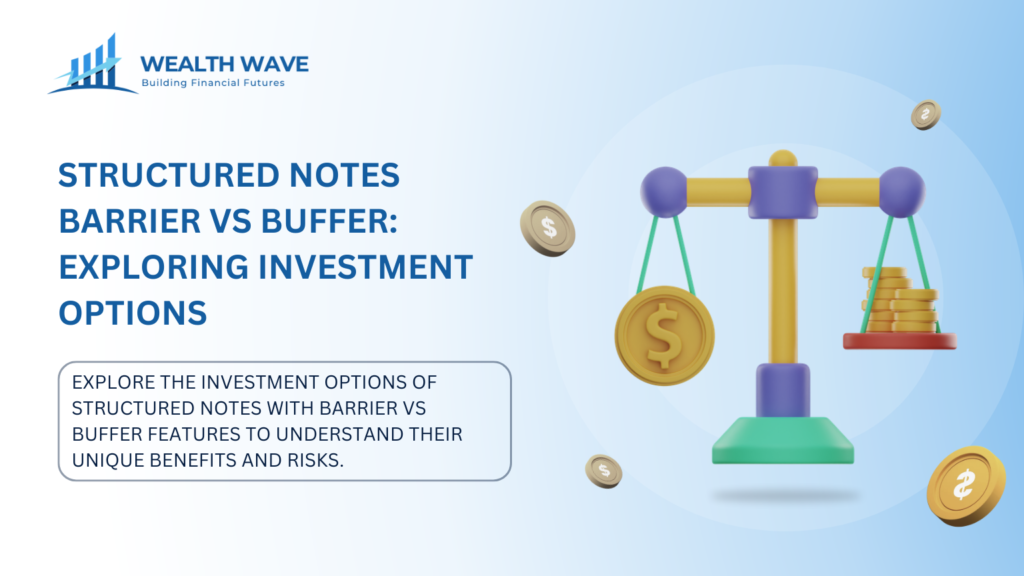
Feeling overwhelmed while trying to safeguard your investments in a market as unpredictable as the weather is something many of us go through. It’s like navigating a ship in stormy seas, not quite knowing where to steer for safety and growth.
That resonates with us deeply because we’ve walked a mile in those shoes too. In our quest for peace of mind, we uncovered the secret weapons for structured notes barrier Vs buffer protections.
We took the plunge into the world of these complex financial instruments because, like you, we craved not just protection for our hard-earned money but also opportunities for potential gains without stepping into unnecessary risk territory.
This piece aims to untangle and illuminate the concepts of barrier and buffer in structured notes—key players in striking a balance between preserving capital and seeking yield amidst market swings.
Through breaking down how each mechanism works, exploring their pros and cons, and considering how they fit within a broader investment strategy, our goal is to make this topic accessible and digestible.
Are you ready to dive deeper into the Structured Notes Barrier Vs Buffer study.
Key Takeaways
- Structured notes combine securities and derivatives, offering unique opportunities to customize investment strategies based on individual risk tolerance.
- Barrier protection in structured notes absorbs losses only after the investment drops below a certain level, providing soft protection for investors’ principal amounts up to that point.
- Buffer protection ensures investors receive their full principal back if the decrease in the reference asset stays within a pre-defined buffer threshold, serving as hard protection against market downturns.
- Understanding how barrier levels and buffer thresholds work is crucial for making informed decisions about investing in structured notes amidst market volatility.
- While barrier and buffer protections offer different levels of security against loss, both aim to balance capital preservation with potential returns from underlying assets.
Understanding Structured Notes

Structured notes are investment products that combine securities and derivatives. They offer unique features, allowing us to customize our investment strategies based on risk tolerance and market conditions.
Definition and Purpose

Structured notes are innovative financial instruments that combine fixed income elements with derivative securities. They aim to provide investors with principal protection while offering potential returns based on the performance of an underlying asset, also known as a reference asset.
These notes come in various forms, including barrier and buffer notes, each designed with specific payoff profiles to meet different investment needs.
Our main purpose for considering structured notes lies in their ability to protect original investments from losses through mechanisms like soft (barrier) and hard (buffer) protection.
By offering these tailored levels of downside protection, structured products and notes attract investors seeking capital preservation along with yield enhancement opportunities.
Types of Structured Notes

Structured notes can take various forms, providing investors with different levels of protection against market fluctuations. Among these types, we find barrier notes and buffer notes.
Barrier notes offer what is known as soft protection; they absorb losses after reaching a specific barrier level. This means our principal investment may be safeguarded down to that specified threshold while still allowing for potential returns based on the performance of the reference asset.
On the other hand, buffer notes provide hard protection by ensuring full principal recovery if declines occur within a certain buffer threshold. In this case, we face no loss until the reference asset drops beyond that predetermined percentage return.
Knowing how barrier and buffer structured investment function helps us make informed decisions aligned with our financial goals and risk tolerance.
Principal Protection in Structured Notes

Principal protection is crucial in structured notes. It helps investors feel secure about their investments while still aiming for returns.
Hard (Buffer) Protection

Buffer protection offers a reliable layer of investment safety in structured notes. It guarantees full principal return as long as the reference asset does not decline beyond a specific buffer threshold.
This feature gives us peace of mind, knowing that our original investment is safeguarded against certain losses.
With buffer notes, we absorb any declines within the set percentage. They provide reassurance while still allowing for potential returns based on market performance. Understanding this form of protection helps us make informed decisions regarding our financial goals and risk management strategies.
Next, we will explore how barriers and buffers function in greater detail.
Soft (Barrier) Protection
Soft protection, or barrier protection, in structured notes provides a unique safety net for our investments. With this type of principal protection, we can safeguard our original investment down to a certain barrier level.
If the reference asset declines within this threshold, we face limited exposure to losses. Essentially, barrier notes absorb any losses until reaching that pre-determined level.
Structured notes like these are attractive because they offer downside protection while allowing potential returns based on market performance. As investors, it’s crucial to understand how soft barriers function alongside other forms of investment protections such as hard (buffer) safeguards.
This knowledge helps us make informed decisions in an ever-changing financial landscape.
How Do Structured Notes Barrier vs Buffer Work?

Barriers and buffers both set levels that help protect our investments. Barriers define points where a structured note might be exposed to loss, while buffers offer a cushion against initial losses.
Barrier Level and Buffer Threshold
Barrier levels and buffer thresholds are crucial in understanding how structured notes function. Barrier notes track a specific level, known as the barrier level, which determines when an investor begins to absorb losses.
If the reference asset’s performance dips below this threshold, we face exposure depending on the extent of that decline. Conversely, buffer notes come with a set percentage called the buffer threshold.
This threshold provides full principal protection for declines within that limit. Loss absorption only kicks in if the decrease exceeds this pre-established percentage.
Investors appreciate these features because they offer tailored protection while allowing us to capitalize on potential gains from underlying assets. Knowing how these components work aids us in making informed decisions about structured note performance amidst market volatility.
Loss Absorption
Loss absorption plays a crucial role in structured notes. With barrier notes, losses begin to occur only after the investment drops below a specific barrier level. This method allows us to retain some principal protection as long as the asset performs within established limits.
In contrast, buffer notes offer a different approach by providing full principal back if the reference asset declines within a predefined buffer percentage. This means we can weather minor downturns without facing any loss on our initial investment.
The variations in loss absorption create distinct opportunities for investors based on their risk tolerance and market outlook. Understanding how these protective features work helps us make informed decisions regarding our investments in structured notes, paving the way for discussions on their benefits and risks.
Benefits and Risks of Barrier and Buffer Notes

Barrier and buffer notes offer unique protection that can fit different investment strategies. While they create opportunities for returns, we must also consider the potential risks tied to market fluctuations.
Tailored Protection Levels
Structured notes allow us to enjoy tailored protection levels that align with our investment goals. Two main types of principal protection exist: barrier and buffer. Barrier notes offer soft protection, absorbing losses until a certain threshold is reached, while buffer notes provide hard protection by ensuring full principal back if the reference asset declines within a specified buffer percentage.
This flexibility enables us to customize our investment strategy based on risk tolerance and market conditions.
Understanding these differences helps shape our approach to structured notes. We can select a product that suits our preferences for downside protection while still aiming for potential returns based on the performance of the reference asset.
By weighing the benefits against risks associated with both barrier and buffer notes, we strategically enhance our portfolio’s resilience amidst market volatility.
Return on Investment Considerations
Return on investment in structured notes involves understanding the balance between potential returns and the protection offered. Barrier notes can absorb losses after reaching a certain percentage, while buffer notes provide full principal back if declines remain within a specified threshold.
This creates unique opportunities for investors to align their expectations with their risk tolerance.
We must consider market volatility as it can significantly impact our investment performance. Both types of structured notes carry distinct benefits that relate directly to how we view return on investment.
While barrier and buffer options contribute to downside protection, they also influence the overall yield of our investment notes based on reference asset performance.
Market Volatility and Investment Performance
Market volatility significantly impacts investment performance. Structured notes, whether barrier or buffer types, can help mitigate these effects. Barrier notes absorb losses after a certain percentage drop in the reference asset.
Buffer notes offer full principal protection as long as declines stay within a specified threshold.
These features provide investors with peace of mind amid unpredictable market conditions. While structured notes allow for potential returns linked to their underlying assets, understanding the level of protection offered by barriers and buffers is crucial for managing risks associated with market fluctuations.
Conclusion

We’ve explored the key elements of structured notes, focusing on the differences between barrier and buffer protection. Understanding these concepts is essential for making informed investment decisions.
We can see that both types offer unique ways to safeguard our principal while allowing potential returns based on underlying asset performance. Choosing the right option depends on our risk tolerance and financial goals.
Which type aligns best with our investment strategy? Let’s reflect on how we can utilize this knowledge to enhance our portfolios. For those interested in going deeper, seeking guidance from a financial advisor could prove beneficial in navigating these complex products.
Embracing structured notes can significantly improve our approach to managing risk within investments. Together, we can leverage these strategies for future success by being proactive and well-informed investors.
FAQs
Q1. What are structured notes with barrier and buffer?
Ans. Structured notes with barrier and buffer are financial instruments that limit or protect against losses.
Q2. How do barriers differ from buffers in structured notes?
Ans. In structured notes, a barrier is a level that, if breached, could lead to significant loss. A buffer on the other hand offers some protection from initial losses.
Q3. Can you explain more about how buffers work in structured notes?
Ans. Sure! In the context of structured notes, a buffer works as a safety cushion. It absorbs initial losses up to its limit before your investment starts losing value.
Q4. Are there any risks involved with using barriers and buffers in structured notes?
Ans. Yes, while barriers and buffers can offer protection against some losses; if the market performs poorly beyond these levels set by those tools, investors could still face substantial risk.




